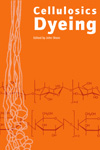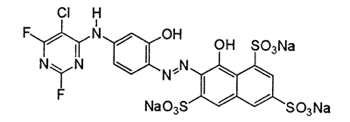Please let me know whether Drimarine K dyes are monofunctional or bifunctional.
Name: Mrs Tanveer
—ADVERTISEMENTS—
Books about the chemistry of dyeingJohn Shore's

Cellulosies Dyeing
Useful information about the chemistry of reactive dyes, and other dye types used for cotton and other plant fibers
Victor B. Ivanov's

Reactive Dyes in Biology and Medicine
Explains use of reactive dyes for staining proteins or carbohydrates
Heinrich Zollinger
Color Chemistry: Synthesis, Properties, and Applications of Organic Dyes and Pigments
Country or region: Pakistan
Message: Please let me know whether Drimarine K dyes are monofunctional or bifunctional.
Drimarene K dyes are monofunctional dyes, with one chlorodifluoropyrimidine reactive system per dye molecule. See the chart from John Shore's book Cellulosics Dyeing at the bottom right of my page about fiber reactive dyes.
Here are some examples of molecular structures of Driamarene K dyes, starting with reactive violet 33:

[image from http://www.worlddyevariety.com/reactive-dyes/reactive-violet-33.html#more-4468]
and another, reactive orange 64:

[image from http://www.worlddyevariety.com/tag/reactive-orange-e3ga]
Reactive yellow 25 is listed as a Drimarene K dye, but it lacks the fluorine atoms of the other two:

[image from http://www.worlddyevariety.com/reactive-dyes/reactive-yellow-25.html]
Each of these examples is obviously monofunctional. There's only one reactive section to the molecule, which is the end with chlorine and/or fluorine atoms; the rest of the molecule is the chromophore, which creates the color, and the connection in between the two parts.
(Please help support this web site. Thank you.)
Posted: Wednesday - June 13, 2012 at 10:06 AM
Follow this blog on twitter here.
Quick Links
- All About Dyes & Dyeing Top -
- Top of this blog -
- FAQ -
- The Dye Forum -
- How to Tie Dye - How to Batik -
- Books - Toys - Plants -
- Top of this blog -
- FAQ -
- The Dye Forum -
- How to Tie Dye - How to Batik -
- Books - Toys - Plants -
More in this category:
- -
Statistics
Total entries in this blog:
Total entries in this category:
Published On: Aug 29, 2012 02:49 PM
Total entries in this category:
Published On: Aug 29, 2012 02:49 PM
